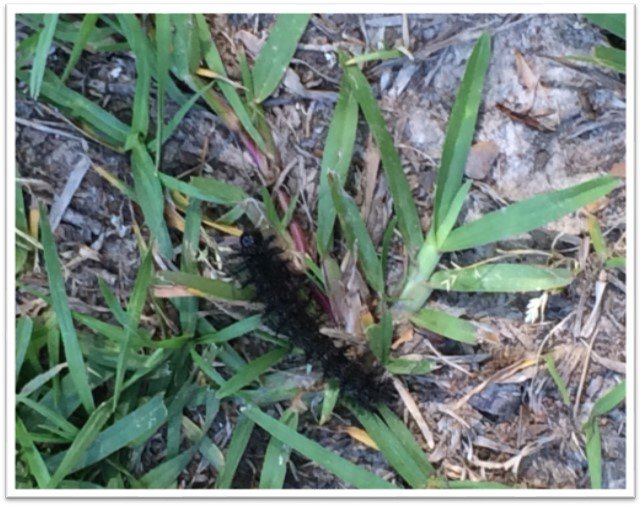
LDWF to Hold Public Hearing On 2024-25 Hunting Regulation NOI Amendments April 22 in Baton Rouge
April 20, 2024
Thibodaux Regional Cancer Institute announces 2nd Annual Festival of Hope
April 21, 2024By Mark Carriere
Every year we look forward to Spring. Everything is in bloom; the weather begins to change, and it is a great time to get out of the house and enjoy the outdoors. Unfortunately, this also means that the insects are ready to come out as well. Some of these are not too friendly on our plants, but some area also not too friendly for us.
Each year many people and their pets are stung by a large caterpillar with black spines that emerges in the spring. So, what is that stinging caterpillar?
This stinging caterpillar is the larval stage of a colorful moth known as the buck moth. Buck moths are fairly large moths with black and white wings and a rust colored abdomen. These moths emerge from the ground in late fall and early winter in Louisiana usually in November through mid-December. Mature buck moths can often be seen in daylight hours a trait that differentiates them from other moths. Females lay eggs in circular clusters on smaller limbs in the canopies of oak trees. Live oaks appear to be the buck moth’s most preferred oak species, but other oaks can also be attacked.
The eggs begin to hatch between mid-February and April in Louisiana. Young larvae, caterpillars, feed on oak leaves and grow rapidly. When the caterpillars are fully developed, they crawl down the tree as a group and look for a place to bury in the ground and pupate. The mature caterpillars are usually 2”-3” in length and are covered by many hollow spines. Each one of their hollow spines contains venom and multiple spines are often injected by a single touch. It is this venom that produces a painful sting when touched.
Buck moth caterpillars are prone to crawl along sidewalks, patios, driveways, and lawns. Contact between buck moth larvae and people, young children, or pets generally happens during this time.
Some people are highly allergic to insect stings. A caterpillar sting can result in a serious medical emergency for people allergic to insect venom. If stung, those who are allergic to insect venom should seek medical attention immediately.
Fortunately, for most people a sting from a buck moth caterpillar can be easily treated. Avoid rubbing the contacted area since this results in more venom entering the skin. Instead, gently wash the area with soap and water and let it air dry. Then take a piece of scotch tape or duct tape and place it over the affected area. Remove the tape and the multiple spines should be attached to the adhesive portion of the tape. Rubbing alcohol or an ice pack can also be used to treat any swelling.
Buck moth caterpillars can cause defoliation of some or the entire canopy of the infested tree. This seems to be especially true for live oaks. Even though defoliation can appear to be drastic and severe, this defoliation rarely causes death of the tree. Trees generally grow back their leaves within a few weeks after defoliation. However, trees already weakened by some other type of stress can have a hard time recovering. If a tree is defoliated by buck moth larvae or other insects, it is prudent to lessen other environmental stresses on the tree until it has time to recover. Supplemental watering is recommended to help trees recover from insect defoliation. To conduct a beneficial supplemental watering, water the tree slowly and deeply starting under the canopy and moving the area around the drip line. Water slowly and deeply to the point where the ground is saturated. The ground should be soft and spongy like it normally is after a long duration winter rain. Repeat the process every 7-10 days until the tree grows its foliage back.

Defoliation caused by Buck Moth infestation. Photo by Justin Dufour, LSU AgCenter.
Although treatment options for buck moth caterpillars do exist for the homeowner, most are expensive and are not very effective. Treatment for buck moth caterpillars is most effective when the larvae are young and concentrated in small areas in the canopy. Two nontoxic pesticides recommend treating larvae in this stage are Bt (Bacillus thuringiensis) and Spinosad. For treatment for caterpillars that are in the mature stage homeowners can use common pyrethroids with active ingredients such as permethrin or bifenthrin that are sold under several different brand names. Unfortunately, most infested trees are too large for homeowners to spray themselves with their equipment. Therefore, a commercial applicator must be used. This can be very costly. In addition, unless all infected trees on a homeowner’s property or in a neighborhood are treated then no significant effect on buck moth populations will be achieved.
Perhaps the most satisfying control method is mechanical control. Caterpillars can be killed by squashing them with something or stomping them with a shoe. Some claim that buck moth caterpillars make a sound like popping bubble wrap when stomped. Remember to be careful not to touch the caterpillars with bare skin even the dead ones.
Continue to enjoy the great weather and wonderful sights of spring in Louisiana. And the next time you see one of those stinging caterpillars you will know what they are, and where they came from. If you have any questions or comments, please contact Mark Carriere at mcarriere@agcenter.lsu.edu or by calling the Pointe Coupee Extension Office at (225)638-5533. More information can also be found on the web at the LSU AgCenter website.







